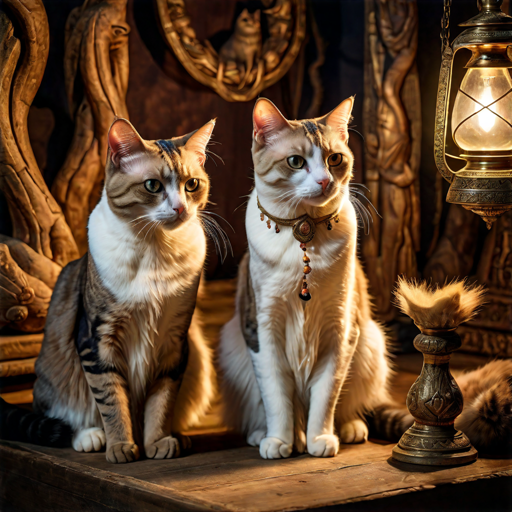Cats, with their mysterious demeanour and graceful presence, have integrated themselves into the very heart of our culture for millennia.
Revered as symbols of mystery, magic, and independence, these elusive creatures have inspired a rich history of mythology, folklore, and superstition across cultures worldwide.
The feline holds a special place in the human imagination, embodying both the divine and the diabolical.
In ancient Egypt, cats were revered as sacred beings, embodying the grace and power of the goddess Bastet. Depicted as a lioness or a cat-headed woman, Bastet was the patroness of home, fertility, and protection. Cats were worshipped as her earthly manifestations, revered for their ability to ward off evil spirits and bring blessings to their human companions. The killing of a cat was considered a grave offence, punishable by death, reflecting the high regard in which these animals were held.
In medieval Europe, cats were associated with both benevolent and malevolent forces, depending on the cultural context. In Celtic mythology, cats were believed to be guardians of the Otherworld, with the ability to travel between worlds and serve as guides to lost souls. In Norse mythology, the goddess Freyja was said to ride in a chariot pulled by two large cats, symbolizing fertility, abundance, and feminine power.
However, cats also carried a darker reputation in European folklore, often associated with witchcraft and the supernatural. During the witch trials of the Middle Ages, cats were frequently accused of being familiars, or demonic spirits, aiding witches in their malevolent deeds. Black cats, in particular, were believed to be omens of misfortune and were often associated with witchcraft and dark magic.
In Japanese folklore, cats are revered as symbols of good luck and prosperity. The Maneki-neko, or “beckoning cat,” is a common talisman believed to bring good fortune to its owner. Often depicted with one paw raised in a beckoning gesture, the Maneki-neko is a familiar sight in Japanese homes and businesses, welcoming prosperity and abundance.
Cats also feature prominently in Japanese mythology, with tales of supernatural felines known as bakeneko and nekomata. These creatures are said to possess magical powers, including shape-shifting and the ability to speak human languages. While some bakeneko are depicted as malevolent spirits, others are portrayed as benevolent protectors of their human companions.
Throughout history, cats have been surrounded by a myriad of superstitions and folk beliefs, often reflecting cultural attitudes and beliefs about these mysterious creatures. In many cultures, it is believed that encountering a black cat crossing one’s path is an omen of bad luck, while in others, black cats are seen as harbingers of good fortune.
In some parts of the world, cats are believed to possess the ability to see into the spirit world, with their keen senses attuned to the presence of supernatural beings. Cats are also associated with the realm of the dead, with some cultures believing that they have the power to guide souls to the afterlife.
From the revered symbols of ancient Egypt to the mystical guardians of Japanese folklore, cats have left an indelible mark on human culture, inspiring awe and reverence in equal measures and reminding us of the profound connection between humans and their feline companions, spanning the realms of history, legend and superstition.





Leave a Reply